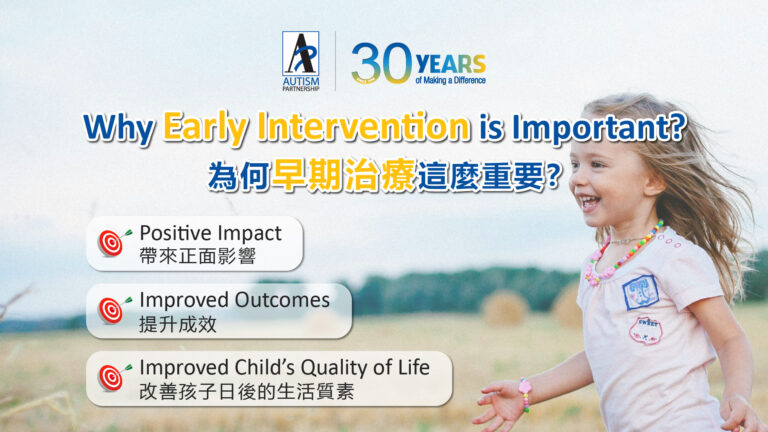[:en]
Learning motivation has a great impact on students’ learning progress in both one-to-one and group settings. In AP, we put huge emphasis on developing and expanding students’ interest on a regular basis. In one-to- one therapy, staff work very hard in expanding students’ interest in toys, activities and social reinforcement. However, it might not be sufficient for students to survive and remain motivated in group settings. Therefore, to prepare students to learn effectively in group settings, we aim at developing reinforcers that are commonly found and are accessible in a classroom setting. Below are some of the reinforcers that we teach and develop in our group programs:
In a kindergarten classroom, teachers often use social praise to reward students. These are not actual/ external reinforcers, like toys. Since students with ASD have challenges in social skills, they may not enjoy teachers’ social praise as much as typically developing children, or those social praise may not be strong enough to motivate them to pay the effort in trying hard. In AP’s group program, teachers choose social praise, often call-and response ones, that are commonly used in school settings. For example, teacher says, “Hip-Hip”, and students responded with “Hurray!”.
The teaching objectives of call- and- response social praise include
(1) Responding to the call- and- response instructions and
(2) Developing students’ interest and desire in earning social praise through group effect.
Typically developing children enjoy participating and winning in competitions。 They love to show off their skills and ability. At the same time, competition is a common element in a lot of children play or games. Therefore, through teaching the concept of competition, we would like our students to acquire
(1) the concept of winning and losing, and
(2) the enjoyment and desire in winning the competition. Some common competitions in our group include: running race, musical chair, competition tokens etc.
Getting a “Big Boy/ Girl” or “Role Model” badge, sticker, stamp or a star on the “Star of the Week” Chart are some of the common rewards that are used in a classroom setting. Students gain teachers’ and peers’ approval by demonstrating appropriate behaviors. These are the common behavioral management strategy that are used in classroom settings in helping students maintain their behaviors.
Being a teacher helper is a privilege. The teacher helper can be the person being in charge of giving out the worksheets or leading the line. These could be a task or demand for children with ASD. They may not see it as a privilege. Therefore, in our group program, teacher will expose and pair these special roles with appropriate behavior in order to increase their desire and interest in earning those privilege.
In group settings, there can be a lot of special privilege, for example, being able to choose or be chosen to do a certain thing first, like being able to line up, coming out to stick the poster or flashcard onto the whiteboard, or redeeming/ being able to exchange for a bigger reward, like participating in the “Star of the Week” party. Privilege can also be embedded reinforcement. Embedded reinforcement is relevant things that we provide/ allow the student to do to reinforce a certain behavior. For example, during story time, a student is being attentive, teacher reinforces his behavior by inviting him to come out and turn a page for the class. Another privilege that we use a lot in a group is “Social Party”. For example, teacher pick a song that all students like. Depending on their performance on their individual goal, whoever maintains their target behavior throughout the lesson gets to join the “social party”.
These are some of the common examples of reinforcement that we develop in our group program. Group learning has the advantage to allow teachers to develop group reinforcement through group effect and peers’ presence. Group reinforcement, like any other skills, require systematic planning and teaching. With a consistent and systematic approach, students with ASD are capable of developing desire and interest in reinforcers that are found and accessible in a natural setting.
Christy Lai, MSc, BCBA, Behavioral Consultant
 |
Ms. Christy Lai is a Board Certified Behavior Analyst with a Master of Science in Applied Behavior Analysis from St. Cloud State University and a Bachelor of Arts in Psychology from the University of Michigan, Ann Arbor. Ms. Lai joined Autism Partnership (AP) in 2011 and she has extensive experience in working with children with ASD. Ms. Christy Lai currently take lead of the case supervision in the new established AP Beijing center. At the same time, she oversees the Little Learners program in Hong Kong and Shanghai and consults families in Asia. She directs overseas training to staff in the Train the Trainer program and provides parent education to families with children with ASD. She also conducts Jumpstart and PIIP programs locally and internationally. In additions, she is keen to take part in overseas ASD conferences and take lead of the design and production of AP teaching materials. Moreover, she helps with producing ABA training videos and articles in the APSPARKS website for public education. |

Please share to let more people know about ABA Therapy Skills.
Facebook: APautism
Wechat: AP-APHK
Learn more about our ABA Services
[:zh]
不管是在個訓還是小組,動機對孩子的學習進度都會有著很大的影響。動機為孩子帶來推動力去努力嘗試和掌握新知識。在AP,強化物的拓展在是非常重要的持續目標之一。在個訓中,老師用心努力拓展學生的興趣,同時配對上社交強化物。然而,僅僅這樣是不足夠的。為了讓學生準備好在小組裡和自然環境裡有效的學習,我們必須幫助他們建立對在教室裡常出現和接觸到的強化物之興趣。以下是一些我們會在小組教學中會花時間去建立和教學的社交強化物和內在動機例子:
在幼兒園的教室裡,老師經常會給表現出眾的學生一些口頭表揚。這些都不是實物強化物(例如:玩具)。由於社交障礙是自閉癥兒童其中的核心挑戰,他們對這些一般正常发展的孩子很享受的口頭表揚並沒感很大的興趣或這些都不足於推動他們努力嘗試或學習。在AP的小組教學中,老師會挑選一些常在當地幼兒園出現的呼應表揚(Call-and-Response),例如:老師:「棒棒!你真棒」,學生回應:「棒棒!你真棒!」。
教學目標包括:
(1)學習如何回應
(2)透過小組氛圍建立學生對這些表揚的興趣和欲望。
正常发展的孩子喜歡在比賽中獲勝。他們享受跟同伴們炫耀他們的本領。很多兒童之間的遊戲也有比賽的元素,因此,我們希望學生
(1)理解輸贏的概念
(2)勝出比賽的興趣。一些常在小組進行的比賽活動包括:賽跑,搶椅子,搶答問題等。
得到老師/同伴認可的會得到一個「大孩子」/「好榜樣」的胸針/貼紙/小印章/在「每周之星表」上得到多一顆星星。這些都是一些非常常見的教室管理制度。讓學生理解這些概念可以幫助到他們保持他們恰當的行為。
「小老師」也是一個得到老師認可以後可以換來的優待。小老師可能是幫忙发作業本或幫老師領小夥伴們去圖書館等。這些對自閉癥的孩子來說可能是一個任務,不是一個特別的榮譽,因此,在小組教學中,老師會在課堂裡增加他們對「小老師」角色的曝光和與正面行為的配對,以增加學生對爭取當「小老師」的欲望。
在小組學習中,優待可以是:獲得選擇權(例如:先出來排隊),特權(例如:出來給大家貼一張圖片到白板上,換得/有資格獲得大獎勵(例如:參加每月之星派對)。優待很多時候是透過嵌入性強化物來給予學生的。嵌入性強化物是指在活動本身中制造機會強化恰當的行為,例如:在看繪本時,因為學生很專注得聽老師講故事,老師獎勵他出來給大家翻到下一頁。另一種經常會在小組裡進行的優待是「社交派對」,比如老師會挑好玩的歌舞,根據個人目標,表現出色的學生獲得參與「社交派對」的機會。
這些都是我們常在小組裡會建立的小組強化物。小組教學有它本身的優勢,它可以允許老師利用小組氛圍跟同伴的影響來促進學生對小組強化物的建立。小組強化物都是需要有系統的教學和計劃去進行。在有一致性和有系統的教學的情況下,自閉癥的學生是有能力建立到對這些在自然環境裡可接觸到的強化物興趣。希望以上資訊能夠幫助大家。

賴靜女士, 理學碩士, 國際認證行為分析師, 應用行為分析治療顧問
 |
賴靜小姐是國際認證行為分析師(BCBA) 並獲有聖克勞德州立大學「應用行為分析」碩士學位及密歇根大學心理學學士學位。她在2011 年加入AP,專注於自閉症兒童的教學工作。
她現時主力為AP北京中心擔任行為分析訓練課程顧問,同時負責監督和帶領香港及上海的Little Learners(學前教育計畫)及為不同亞洲家庭提供諮詢服務。賴靜小姐亦積極指導海外導師培訓計畫、為育有自閉症孩子的家長提供學習課程、並於香港及海外進行躍進課程及革新密集訓練課程。此外,她亦多次參與海外研討會、帶領創作AP各款教學工具、以及為「AP課堂(微信小程序)」自閉症資源平台制作多個ABA 教學視頻及撰寫文章,樂於與大眾分享ABA資訊。 |

請分享,讓更多人了解自閉症及學習更多應用行為分析( ABA)的治療技巧。
Facebook: APautism
微信號: AP-APHK
[:]

Every little life is a special present for a family. From the time a baby is born, parents journey through lots of highs and lows, wishing for their child to grow up with a big smile, make great friends, find their own way in a job they love, and create a happy family. However, for […]

Autism Spectrum disorder can be diagnosed as early as 18 months. Research shows strong evidence on how effective Applied Behavior Analysis (ABA) can help children with Autism. It helps to deal with children’s challenging behaviors such as inattention, aggression, self-stimulation, etc. Howard, et al (2005) conducted a study to compare the effectiveness of 3 treatment […]

In today’s society where information flows freely, parents can easily receive different messages. However, these messages are often debatable or even wrong. Believing wrong information can easily lead to misguided choices and delay treatment, the consequences of which may last a lifetime. When conducting one-on-one consultations with parents, I often hear the following misguided views […]
Please share to let more people learn about ASD and ABA therapy:
AP holds the belief that with quality Autism Partnership Method (APM) treatment, individuals with autism should reach their fullest potential and achieve the greatest degree of independence and highest quality of life possible.

Sign up now to get ABA and Autism related news delivered to your inbox. Enter your email to get started
Hong Kong Center
Kowloon Center

All information received will always remain confidential. We will contact you as soon as we review your message. Thanks